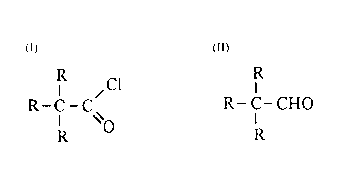Some of the information on this Web page has been provided by external sources. The Government of Canada is not responsible for the accuracy, reliability or currency of the information supplied by external sources. Users wishing to rely upon this information should consult directly with the source of the information. Content provided by external sources is not subject to official languages, privacy and accessibility requirements.
Any discrepancies in the text and image of the Claims and Abstract are due to differing posting times. Text of the Claims and Abstract are posted:
| (12) Patent Application: | (11) CA 2252301 |
|---|---|
| (54) English Title: | PREPARATION OF ACID CHLORIDES |
| (54) French Title: | PREPARATION DE CHLORURES D'ACIDE |
| Status: | Deemed Abandoned and Beyond the Period of Reinstatement - Pending Response to Notice of Disregarded Communication |
| (51) International Patent Classification (IPC): |
|
|---|---|
| (72) Inventors : |
|
| (73) Owners : |
|
| (71) Applicants : |
|
| (74) Agent: | NORTON ROSE FULBRIGHT CANADA LLP/S.E.N.C.R.L., S.R.L. |
| (74) Associate agent: | |
| (45) Issued: | |
| (22) Filed Date: | 1998-10-30 |
| (41) Open to Public Inspection: | 1999-05-07 |
| Availability of licence: | N/A |
| Dedicated to the Public: | N/A |
| (25) Language of filing: | English |
| Patent Cooperation Treaty (PCT): | No |
|---|
| (30) Application Priority Data: | ||||||
|---|---|---|---|---|---|---|
|
In a method of making an acid chloride having the general formula
(see fig. I)
where each R contains no unsaturated groups and is preferably independently
selected from aliphatic from C1 to C7 and aryl from C6 to C15, a solution is formed
in an inert solvent of an aldehyde having the general formula
(see fig. II)
and chlorine gas is sparged into said solution. The reaction between the
aldehyde and the chlorine gas to produce the acid chloride is performed in the
absence of a catalyst, in the absence of an initiator, and in the absence of
ultraviolet light. A chlorinated acid chloride can be prepared from the acid
chloride by reacting it with additional chlorine in the presence of a chlorine free
radical generator.
Dans une méthode de préparation de chlorure d'acide de formule générale (voir fig. I), où aucun R ne contient de groupe insaturé et est préférablement choisi indépendamment à partir d'un aliphatique C1 à C7 et d'un aryle C6 à C15, une solution est formée dans un solvant inerte d'un aldéhyde de formule générale (voir fig. II), solution dans laquelle on fait barboter du chlore gazeux. La réaction entre l'aldéhyde et le chlore gazeux pour produire le chlorure d'acide est effectuée sans catalyseur, sans initiateur et sans lumière ultraviolette. Un chlorure d'acide chloré peut être préparé à partir du chlorure d'acide par réaction avec du chlore additionnel en présence d'un générateur de chlore radicalaire libre.
Note: Claims are shown in the official language in which they were submitted.
Note: Descriptions are shown in the official language in which they were submitted.

2024-08-01:As part of the Next Generation Patents (NGP) transition, the Canadian Patents Database (CPD) now contains a more detailed Event History, which replicates the Event Log of our new back-office solution.
Please note that "Inactive:" events refers to events no longer in use in our new back-office solution.
For a clearer understanding of the status of the application/patent presented on this page, the site Disclaimer , as well as the definitions for Patent , Event History , Maintenance Fee and Payment History should be consulted.
| Description | Date |
|---|---|
| Time Limit for Reversal Expired | 2003-10-30 |
| Application Not Reinstated by Deadline | 2003-10-30 |
| Deemed Abandoned - Failure to Respond to Maintenance Fee Notice | 2002-10-30 |
| Inactive: Cover page published | 1999-05-19 |
| Application Published (Open to Public Inspection) | 1999-05-07 |
| Inactive: IPC assigned | 1999-01-11 |
| Inactive: IPC assigned | 1999-01-11 |
| Inactive: First IPC assigned | 1999-01-11 |
| Inactive: IPC assigned | 1999-01-11 |
| Classification Modified | 1999-01-08 |
| Filing Requirements Determined Compliant | 1998-12-16 |
| Inactive: Filing certificate - No RFE (English) | 1998-12-16 |
| Application Received - Regular National | 1998-12-10 |
| Abandonment Date | Reason | Reinstatement Date |
|---|---|---|
| 2002-10-30 |
The last payment was received on 2001-10-09
Note : If the full payment has not been received on or before the date indicated, a further fee may be required which may be one of the following
Please refer to the CIPO Patent Fees web page to see all current fee amounts.
| Fee Type | Anniversary Year | Due Date | Paid Date |
|---|---|---|---|
| Registration of a document | 1998-10-30 | ||
| Application fee - standard | 1998-10-30 | ||
| MF (application, 2nd anniv.) - standard | 02 | 2000-10-30 | 2000-10-02 |
| MF (application, 3rd anniv.) - standard | 03 | 2001-10-30 | 2001-10-09 |
Note: Records showing the ownership history in alphabetical order.
| Current Owners on Record |
|---|
| OCCIDENTAL CHEMICAL CORPORATION |
| Past Owners on Record |
|---|
| JAMES G. COLSON |
| RAMESH KRISHNAMURTI |
| ROSE ADINOLFE |